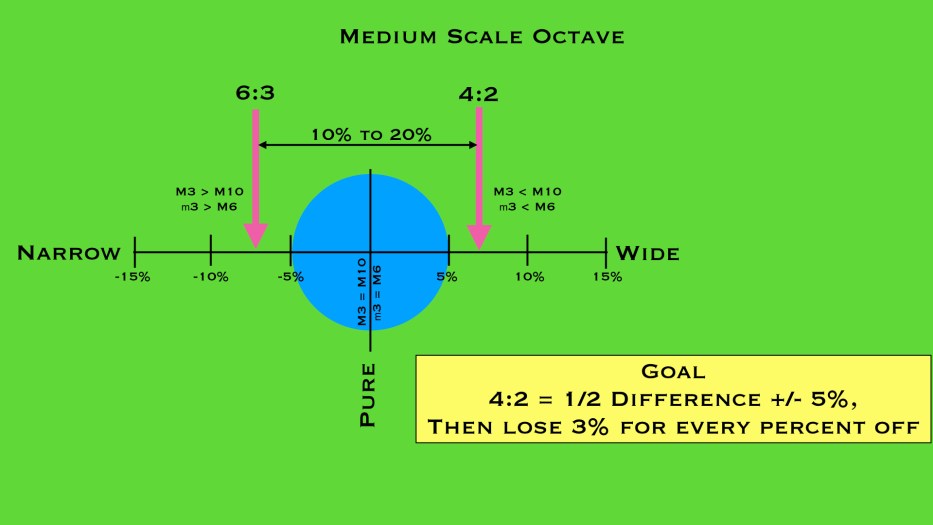This page lists the new octave scoring feature of the website.
Octave 001 Large Scale - 48.0%
Octave 002 Small Scale - 100.0%
Octave 003 Small Scale - 100.0%
Octave 004 Small Scale - 100.0%
Octave 005 Small Scale - 100.0%
Now you can send me recordings of a mid-range octave and I can filter, measure and score it for you.
Use the octave flow chart below to determine how to tune the octave to its best size.

Graphical Representation of Octave Sizes
Note: The blue dot represents the human limit of our ability to hear differences in beat speeds. (5%)









Note: This octave would not sound good. It sounds better as a pure 4:2/very narrow 6:3.
How to Send in Your Octaves to be Scored.
Just play the following intervals, record them, and email them to me at mark-at-howtotunepianos-dot-com (Replace -at- with @, and -dot- with a dot. This is done to reduce internet bots from harvesting my email address for spam.)
Play each interval with single strings, for about 2 seconds.
Play the A3A4 and F3F4 octaves.


Then play the 4:2 and 6:3 tests for F3F4.


Finally, play the 4:2 and 6:3 tests for A3A4.


The Criteria for Tuning These Octaves Clean:
If the 4:2 and 6:3 are close enough, they will sound pure when tested. I.e. M3=M10 and m3 = M6. (Small Scale)
If they are not close enough for that, you will not be able to tune them as pure 4:2/pure 6:3, so they will test as wide 4:2/narrow 6:3. If this octave sounds good, it's Medium Scale.
If the 4:2 and 6:3 are really far apart, the wide 4:2/narrow 6:3 will sound funky. Pure 4:2/very narrow 6:3 is better, not perfect, but probably the best we can do. That's Large Scale.
Marking
The size of the 4:2 is calculated based on the ratio of the M3/M10 beat speeds in percent.
The size of the 6:3 is calculated based on the ratio of the m3/M6 beat speeds in percent.
If the ratio is 5% or less, the octave is said to be "pure" at that partial, as far as we can tell from the tests.
If the difference between the 4:2 and 6:3 is 10% or less, the octave is said to be Small Scale because it is possible to tune both the 4:2 and 6:3 pure.
If the difference between the 4:2 and 6:3 is between 10% and 20%, the octave is said to be Medium Scale because we can't tune the 4:2 and the 6:3 pure at the same time but they are still close enough to each other for the octave to sound clean.
If the difference between the 4:2 and 6:3 is more than 20%, the octave is said to be Large Scale because the 4:2 and the 6:3 are too far apart to sound good as a wide 4:2/narrow 6:3 - the better sound is a pure 4:2/very narrow 6:3.
Take a look at the following score sheet:


The 4:2 test measured 3.7% wide. The 6:3 test measured 4.9% wide. The difference is 1.2%.
Because the difference is less than 10%, we say this is a Small Scale octave.
If we scored the 4:2 and the 6:3 based on the following criteria, they would both score the same, so we only score the 4:2 with more marks lost.
Criteria for Small Scale
The difference between the 4:2 and 6:3 is 1.2%. (4.9% - 3.7%)
We calculate half the difference. In this case, it works out to 0.6%, (1.2% / 2) so our goal for the 4:2 is 0.6% wide.
(Actually, because this is a rare "reversed" octave, the goal should be 0.6% narrow for the 4:2, but we will leave that for now.)
The actual size of the 4:2 is 3.7%. We are given a window of 5% which means our 4:2 could have been between 0.6% + 5% (5.6%) and 0.6% - 5% (-4.4%) and still score 100%.
Since this 4:2 is 3.7% wide, which is less than 5.6% wide, it scores 100%.